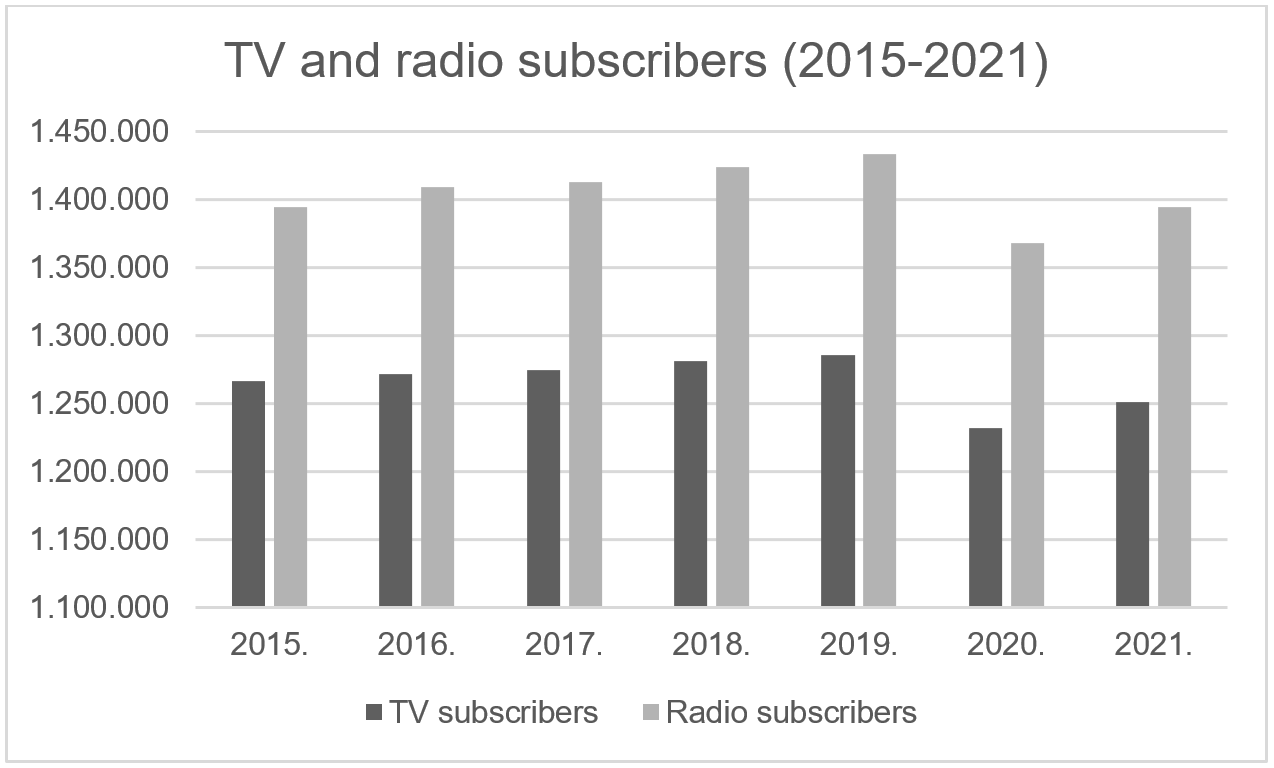A total of 140 theatres operated from 1 September 2021 to 31 August 2022. A number of professional theatres have permanent venues at their disposal, either in-house or located somewhere else. Therefore, along with 80 professional theatres, there were 12 operating permanent venues. In addition, there were 27 professional children’s theatres out of which 7 puppet theatres. A total of 33 amateurs’ theatres operated in the 2021/2022 season (Croatian Bureau of Statistics, 2022d).
As noted by the Croatian Bureau of Statistics (2022d), after an extremely difficult 2020/2021 theatre season due to the epidemiological measures introduced to prevent the spread of COVID-19, a better season for performing arts followed in terms of the number of plays performed and the number of visitors. Professional theatres for all ages performed 41% more plays in Croatia and abroad, and had 116% more visitors than in the previous season. ‘A total of 9 243 plays were performed, which is 73% more than in the previous season. The plays in the Republic of Croatia and abroad were attended by 1 149 037 visitors, which is an increase of 160% compared to the 2020/2021 season. A total of 1 311 titles were performed in all theatres. Out of that, 830 titles, or 63%, were created by domestic authors’ (Croatian Bureau of Statistics, 2022d).
There is also a noticeable recovery of the concert season for professional ensembles, orchestras and choirs: compared to the 2020/2021 season, the number of performed concerts increased by 31% and their attendance by 181%. A total of 573 concerts, performances and festivities were performed, which were attended by 151 698 visitors. It has to be noted that in the 2021/2022 season, 33 professional orchestras and ensembles operated, out of which 6 were symphony and large orchestras, 6 chamber orchestras and 21 chamber ensembles. The professional choir performed 24 concerts, that is, two concerts more than in the previous season. They were attended by 7 650 visitors, that is, 226% more than in the 2020/2021 season. Taking also the attendance to the shows of LADO – National Folk Dance Ensemble of Croatia, this amounted to more than 208 thousands visitors to professional orchestras, ensembles and choirs shows. The Table 4 shows also that in 2021 the situation still differs within subsectors and that the pandemic has taken its toll in that year still.
Table 4: Attendance data for specific cultural fields (in thousands), 1983-2021
|
Year |
Professional theatres* |
Cinemas |
Museums and museum collections |
Professional children‘s theatres* |
Professional orchestras, ensembles and choirs* |
|
1983 |
1 101 |
21 324 |
N/A |
N/A |
N/A |
|
1994 |
643 |
4 562 |
580 |
N/A |
N/A |
|
1997 |
705 |
3 233 |
1 129 |
N/A |
N/A |
|
2000 |
658 |
2 743 |
1 073 |
N/A |
N/A |
|
2002 |
879 |
2 766 |
1 074 |
426 |
279 |
|
2003 |
1 024 |
2 343 |
1 268 |
429 |
286 |
|
2004 |
1 043 |
2 976 |
N/A |
436 |
374 |
|
2005 |
952 |
2 174 |
N/A |
374 |
409 |
|
2006 |
941 |
2 669 |
1 674 |
370 |
378 |
|
2007 |
959 |
2 483 |
N/A |
419 |
443 |
|
2008 |
1 067 |
3 283 |
N/A |
404 |
318 |
|
2009 |
1 033 |
3 524 |
2 191 |
379 |
323 |
|
2010 |
1 184 |
3 355 |
N/A |
387 |
320 |
|
2011 |
1 261 |
3 558 |
N/A |
399 |
290 |
|
2012 |
1 211 |
4 064 |
2 284 |
399 |
294 |
|
2013 |
1 161 |
4 156 |
N/A |
569 |
332 |
|
2014 |
1 374 |
4 079 |
N/A |
386 |
356 |
|
2015 |
1 245 |
4 347 |
2 710 |
477 |
270 |
|
2016 |
1 690 |
4 532 |
N/A |
487 |
317 |
|
2017 |
1 540 |
4 814 |
N/A |
555 |
380 |
|
2018 |
1 435 |
4 859 |
2 912 |
570 |
469 |
|
2019 |
1 485 |
5 026 |
N/A |
557 |
297 |
|
2020 |
917 |
1 503 |
N/A |
394 |
175 |
|
2021 |
729 |
2 466 |
1 320 |
354 |
208 |
Source: Republic of Croatia – Central Bureau of Statistics, Statistical Yearbooks for noted years and from ‘First Releases’ of ’Cinematography’, ‘Artistic production and live performances’ and ‘Museums, galleries and collections’ (see also Sources and links).
Note: Table is compiled from four different Tables (Culture and Arts, Museums and Museum Collections, Professional Children’s Theatres, and Professional Orchestras, Ensembles and Choirs) given in the section “Culture, Arts and Sport” in all yearbooks and ‘First release’ data collections(see also Sources and links).
* The data provided concerns seasons not years, thus data for 2002 reflects the season 2001/2002.
Figure 3: Television and radio subscribers in Croatia (2015-2021).
 Source: Croatian Bureau of Statistics, 2022) Culture. Statistics in Line.
Source: Croatian Bureau of Statistics, 2022) Culture. Statistics in Line.
There have not been any representative surveys taken in recent years on receptive or on active participation. In addition, there are no special surveys monitoring the participation of national minority groups or immigrant groups in cultural life or specific research on the composition of audiences at multicultural or other type of festivals.

Comments are closed.